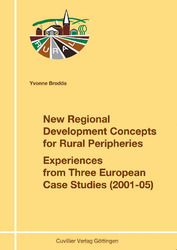| Departments | |
|---|---|
| Book Series (96) |
1378
|
| Nachhaltigkeit |
3
|
| Gesundheitswesen |
1
|
| Humanities |
2364
|
| Medienwissenschaften | 16 |
| Theology | 57 |
| Philosophy | 102 |
| Law | 422 |
| Economics | 850 |
| Social sciences | 416 |
| Sports science | 48 |
| Psychology | 233 |
| Educational science | 190 |
| History | 182 |
| Art | 111 |
| Cultural studies | 166 |
| Literary studies | 116 |
| Linguistics | 88 |
| Natural Sciences |
5406
|
| Engineering |
1793
|
| Common |
98
|
|
Leitlinien Unfallchirurgie
5. Auflage bestellen |
|
Advanced Search
New Regional Development Concepts for Rural Peripheries (Volume 4) (English shop)
Experiences from Three European Case Studies (2001-05)
Yvonne Brodda (Author)Preview
Table of Contents, Datei (60 KB)
Extract, Datei (94 KB)
The framing conditions for rural areas in Europe have changed dramatically in the past thirty years. As a result, regional disparities proliferate between prospering and structurally weak areas, between innovative and stagnating regions, between centres and peripheries. This situation coincides with an increasing differentiation of rural areas, which vary considerably in their economic structure and development prospects.
Changes have also occurred in policies that are relevant for rural areas. New concepts and strategies of regional policy have been the subject of much debate since the mid-1990s. First formulated at the EU-level in the “Cork Declaration” (1996), the concept of integrated rural development is particularly important. Integrated development stands for an approach based on a consistent use of endogenous potentials, a multi-sector regional and local implementation level, the participation of those affected, the development and use of network structures and partnerships, as well as the implementation of regional management and capacity building.
In view of the far-reaching structural changes, the classic steering instruments of the national authorities have proven to be insufficient. Other levels appear to be more appropriate to address many of the current issues. Responsibilities of the nation state are transferred either “upstream”, that is to higher-level authorities, e.g. the European Union, or “downstream” to regional and local authorities. At the same time, the relationship of public administration, economy and civil society is being reformed especially at the regional level, which can be summarised under the term of regional governance.
The above sets the context for this study, which analyses new concepts, strategies and instruments in regional development policy, their implementation at the regional and local levels and finally, their relevance for the development perspectives of rural peripheries. The study rests upon three qualitative case studies, carried out in three different European regions: the Western Isles and Skye & Lochalsh (Scotland), the province Jämtland (Sweden) and the region Eisenwurzen (Austria). The detailed evaluation of the case studies, leads on to a comparative analysis of the examined national and regional and/or local concepts, as well as the employed strategies and instruments for regional development. Whilst showing many commonalities, the results reflect the heterogeneous development paths that can be identified in regional development policy in general.
| ISBN-13 (Printausgabe) | 3869554800 |
| ISBN-13 (Hard Copy) | 9783869554808 |
| ISBN-13 (eBook) | 9783736934801 |
| Language | English |
| Page Number | 234 |
| Edition | 1 Aufl |
| Book Series | RURAL |
| Volume | 4 |
| Publication Place | Göttingen |
| Place of Dissertation | Hochschule Vechta |
| Publication Date | 2010-12-21 |
| General Categorization | Dissertation |
| Departments |
Social sciences
Geosciences |








